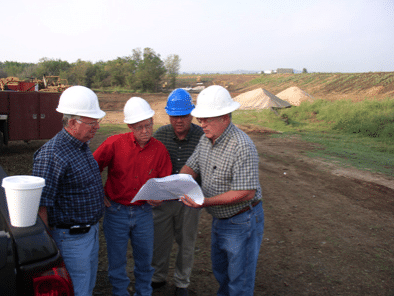Caney Valley CD Legislative Watershed Tour
Caney Valley Conservation District Discusses Flood Control with Legislators
State Sen. John Ford and Reps. Steve Martin and Earl Sears attended a tour of area watershed flood control dams in the Double Creek watershed in Washington County on Sept. 24. The dams in the Double Creek Watershed protect U.S. Highway 75 and the community of Ramona. Caney Valley Conservation District hosted the tour.

As flood control dams across the nation reach the end of their design life, many need rehabilitation to extend their benefits for the future. The tour of three dams in the Double Creek watershed gave the legislators a close look at one watershed site that is under rehabilitation, one that has not been rehabilitated, and one that has been completely rehabilitated.
“The Caney Valley Conservation District board of directors appreciates the legislators taking time to tour the upstream watershed structures and their continued support of the watershed projects,” said Waymon Montgomery, chairman of the conservation district.
Conservation district representatives also discussed the need to reevaluate the Cotton-Coon Mission Creeks Watershed structures. Not all of the planned structures in the watershed have been built. The sites of those proposed structures are upstream from Bartlesville and Dewey as well as U.S. Highways 60 and 75.
“They were not built due to difficulty obtaining land easements because of mineral rights and a shortage of funding,” Montgomery said. “These watershed structures would have helped greatly in the June 11th flash flood that affected the eastside of Dewey,” he said.
For state rainfall, 2007 has not been a typical year. According to the Oklahoma Conservation Commission, the state’s $2 billion infrastructure of 2,105 small watershed flood retarding dams provide an average of $71 million in annual public benefits. That is estimated at $39.5 million in flood damage reduction and $31.5 million in non-flood related benefits including water supply, wildlife habitat, recreation and sediment retention. But this year the record rainfall resulted in an additional $290 million damage reduction for the period of May and June and an additional $30 million damage reduction in August. And 330 more dams that have been planned but for which construction has not been funded could have provided another estimated amount of almost $50 million in damage reduction for those two time periods.
Other benefits include 1,532 bridges and 20,541 farms and ranches benefited by the dams. The USDA Natural Resource Conservation Service estimates that the structures help prevent over nine million tons of sediment flowing downstream. And 42 of the dams provide municipal water supply in locations across the state, according to the Conservation Commission.
In 2000 Oklahoma Congressman Frank Lucas authored the Small Watershed Rehabilitation Amendments Act. The law authorized substantial repair and overhaul of flood control dams reaching the end of their design life. As the dams functioned as they were built to do, some have filled with sediment or suffered other effects of time. In many cases dams that were originally built in rural and agricultural settings have now been enveloped by suburban development. In any case where one human life could be endangered should such a dam fail, the rating of the dam changes to “high hazard” status.
Significant changes are required to bring a dam like that into safety specifications. As of January 2007 there were 188 high hazard structures requiring rehabilitation to comply with safety standards. The number continues to grow as more homes are built downstream in the breach inundation area. The average cost to rehabilitate a dam to meet high hazard criteria is $1 million. When funds area available to rehabilitate a dam, the cost share ratio is 65 percent federal and 35 percent state funding. Rehabilitation extends the benefits of a dam for another 100 years.
